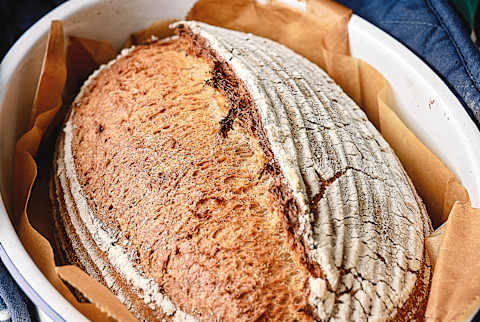The Unexpected Ingredient You Should Add To Your Next Sourdough Loaf

I don't know about you, but I was absolutely one of the many people who started a sourdough starter during the earlier months of lockdown. And while I've mastered my go-to loaf, I'm always looking fo fun things to try changing up that bake. So when I caught a glimpse of this recipe in Whole Grain Sourdough at Home, which takes my favorite toast topping and flips it into the dough mixture, I simply had to know more.
"This loaf marries peanut butter and whole wheat flour for a full-flavored, nutritious, lovely bake," shares author and recipe developer Elaine Boddy. "The peanut butter adds great extra flavor to the loaf, really enhancing the sourness, as well as adding a silkiness to the dough as you work with it."
Not a peanut butter person? Boddy says other nut butters work well too—just follow these guidelines: "Try adding about ⅓ cup of almond butter or 3 tablespoons of cashew butter instead of peanut butter to experience the different flavors and outcomes."
If you're scanning the recipe and wondering what a batard is, it's just another name for the oval loaf that this recipe calls for—one of two traditional sourdough shapes, the other being round. The benefit of the oval shape is twofold: You'll get more slices, and they'll be more consistent in size and shape—all the better for morning toast.
The Peanut Butter Batard Master
Makes 1 standard loaf
Preparation
Feed all of your starter 50 grams (½ cup) of flour and 50 grams (¼ cup) of water. When it is active and ready to use, begin your dough. Prepare your banneton, or a bowl with rice flour (see page 14), and set aside your lidded baking pan of choice, plus parchment paper.
Ingredients
- ⅜ cup active starter
- 1½ cups water
- 2½ cups strong white bread flour
- 1⅔ cups whole wheat flour
- ¾ cup unsalted peanut butter
- 1 tsp. salt, or to taste
Method
- In the early evening, in a large mixing bowl, roughly mix together all of the ingredients, including the peanut butter; cover the bowl and leave it on the counter for 2 hours. The peanut butter will not yet be incorporated into the dough, which will occur during the pulls and folds to follow.
- After 2 hours, start pulling and folding the dough until it comes together into a nice ball. The dough will be heavy but stretchy, as well as sticky as the peanut butter mixes with the other ingredients and the oils loosen up with the warmth of your hands. Cover the bowl and leave it on the counter.
- Over the next few hours, do 3 more sets of pulls and folds on the dough, covering the bowl after each set. The peanut butter will continue to mix in and you will be able to feel and see the difference in the dough compared to other doughs that do not include peanut butter. Perform the final set of pulls and folds before going to bed.
- Leave the covered bowl on the counter overnight, typically 8 to 10 hours, at 64 to 68°F.
- In the morning, you will see that the dough loves peanut butter! The dough will have doubled, if not more, overnight, with a smooth surface.
- Sprinkle an extra layer of rice flour into the banneton. To place the dough into an oval banneton, lift and pull the dough over itself along one side of the bowl. Turn the bowl around completely to the other side and pull the dough on that side again in a line to create a fat sausage of dough. This will be a firm dough full of strength, but even so, do not be heavy-handed; protect the lovely work your starter has done. Gently place the dough, smooth side down, into the banneton, sprinkling extra rice flour down the sides and across the top of the dough, cover it again with the same shower cap, and place it in the fridge for at least 3 hours.
- For a round banneton, perform a final set of pulls and folds, typically once around the bowl, to pull the dough into a firm ball, then proceed as in the previous step.
- After a minimum of 3 hours and a maximum of 10 in the fridge, when you are ready to bake, preheat the oven to 425°F convection or 450°F conventional.
- Remove the cover from the banneton, then place the parchment paper over the top of the banneton and the pan upside down over the top of them both. With one hand under the banneton and one on the pan, turn it all over together to turn the dough out of the banneton and into the pan.
- Score the dough cleanly and decisively; it will be firm and inviting to score. I scored my loaf with a single long line off center, about ⅜ inch deep, along one side.
- Put the lid on the pan and bake for 50 minutes. After 50 minutes if you would like more color on your loaf, place the pan back in the hot oven, minus the lid, for 5 to 10 minutes.
- Once baked, carefully remove the loaf from the pan, saving the parchment paper for next time, and allow the baked loaf to cool on a wire rack for at least an hour before slicing.
